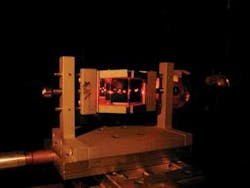Opaque silver is made to transmit light
An ordinarily opaque thin silver film can be made to efficiently transmit light, researchers at the University of Exeter (Exeter, England) have shown. The trick is to “impedance-match” the film by sandwiching it with thin zinc sulfide (ZnS) films, which have a refractive index near the right magnitude (more conventionally, antireflection optical thin films help to impedance-match a glass element with the air around it, increasing transmission). For example, when sandwiched with 217 nm ZnS films, a 40.3 nm structureless silver film at normal incidence transmitted about 37% at 600 nm-80 times higher than an equivalent setup without the ZnS films. Use of other sandwich materials could boost the transmission further toward the theoretically possible 100%.
The researchers generalize their results to quantum-mechanical systems; they say that any tunnel barrier can be made 100% transmissive by sandwiching the barrier with wells of the proper depth and thickness. The researchers chose an optical basis for their experiment for convenience, but would like to see confirming results in quantum systems. Contact Ian Hooper at [email protected].

